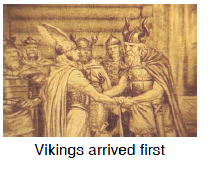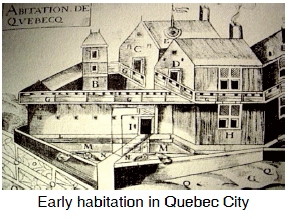The land that is now known as Canada was first home to many different nations of Indigenous peoples with distinctly different languages and social organizations. What they shared was a great ability to live with the land and it was only by copying Indigenous ideas like the snowshoe, birchbark canoes and pemmican: dried lean meatpemmican that the Europeans were able to survive the harsh winters and develop a vast fur trade that eventually spread European influence across the country.
 First, Eric the Red and Leif the Lucky brought Viking settlements to the island of
Newfoundland. Then Cartier navigated up the St. Lawrence in
1535. Finally Champlain established the first permanent
European settlement on the St. Lawrence in 1608 on the
site of what is now Quebec City. Early government in
the settlement was under the control of the fur trading
and settlement companies. Settlement was sparse and
based on the seigneurial system: a feudal system of land ownership whereby huge grants put land ownership in the hands of seigneurs who rented sections to farmersseigneurial system.
Then, in 1663 when the Sun
King, Louis XIV, was young and
newly ascended to the throne of
France, when Molière: French dramatist and comic actor who lived from 1622-1673Molière was
satirizing the French upper
classes in his plays, Pepys: English diarist and naval administrator; lived from 1633-1703Pepys was
recording details of the horrible
Black Plague in his diary, and
Descartes' ideas were the topic
of dinner party conversations in
Paris - this small snowbound outpost of New France was
officially recognized as a Royal Colony.
First, Eric the Red and Leif the Lucky brought Viking settlements to the island of
Newfoundland. Then Cartier navigated up the St. Lawrence in
1535. Finally Champlain established the first permanent
European settlement on the St. Lawrence in 1608 on the
site of what is now Quebec City. Early government in
the settlement was under the control of the fur trading
and settlement companies. Settlement was sparse and
based on the seigneurial system: a feudal system of land ownership whereby huge grants put land ownership in the hands of seigneurs who rented sections to farmersseigneurial system.
Then, in 1663 when the Sun
King, Louis XIV, was young and
newly ascended to the throne of
France, when Molière: French dramatist and comic actor who lived from 1622-1673Molière was
satirizing the French upper
classes in his plays, Pepys: English diarist and naval administrator; lived from 1633-1703Pepys was
recording details of the horrible
Black Plague in his diary, and
Descartes' ideas were the topic
of dinner party conversations in
Paris - this small snowbound outpost of New France was
officially recognized as a Royal Colony.
 Guided by his clever first minister, Jean-Baptiste
Colbert, Louis sent a Governor and an energetic
Intendant: an important
administrative official in New France, responsible for finance, justice and police in the colony. Jean Talon was the first.Intendant - Jean Talon - to run the colony and sit on its
Sovereign Council. He also shipped a number of young
women to Canada to make up for a shortage of eligible brides and encourage population growth in the colony. (See Les Filles du Roi).
Guided by his clever first minister, Jean-Baptiste
Colbert, Louis sent a Governor and an energetic
Intendant: an important
administrative official in New France, responsible for finance, justice and police in the colony. Jean Talon was the first.Intendant - Jean Talon - to run the colony and sit on its
Sovereign Council. He also shipped a number of young
women to Canada to make up for a shortage of eligible brides and encourage population growth in the colony. (See Les Filles du Roi).
- BASQUE WHALERS
- JACQUES CARTIER
- FISHING INDUSTRY 1500s - 1700s
- FUR TRADE 1500s - 1700s
- SAMUEL DE CHAMPLAIN
- SEIGNEURIAL SYSTEM
- FEUDALISM IN EUROPE
- LOUIS XIV
- JEAN-BAPTISTE COLBERT
- LES FILLES DU ROI
- GOVERNMENT OF NEW FRANCE
- JEAN TALON
- DAILY LIFE IN NEW FRANCE
- ARTS & CULTURE 1600s
- CONTEMPORARY EVENTS 1600s
